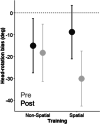Training spatial hearing in unilateral cochlear implant users through reaching to sounds in virtual reality
- PMID: 36905419
- PMCID: PMC10313844
- DOI: 10.1007/s00405-023-07886-1
Training spatial hearing in unilateral cochlear implant users through reaching to sounds in virtual reality
Abstract
Background and purpose: Use of unilateral cochlear implant (UCI) is associated with limited spatial hearing skills. Evidence that training these abilities in UCI user is possible remains limited. In this study, we assessed whether a Spatial training based on hand-reaching to sounds performed in virtual reality improves spatial hearing abilities in UCI users METHODS: Using a crossover randomized clinical trial, we compared the effects of a Spatial training protocol with those of a Non-Spatial control training. We tested 17 UCI users in a head-pointing to sound task and in an audio-visual attention orienting task, before and after each training. <br>Study is recorded in clinicaltrials.gov (NCT04183348).
Results: During the Spatial VR training, sound localization errors in azimuth decreased. Moreover, when comparing head-pointing to sounds before vs. after training, localization errors decreased after the Spatial more than the control training. No training effects emerged in the audio-visual attention orienting task.
Conclusions: Our results showed that sound localization in UCI users improves during a Spatial training, with benefits that extend also to a non-trained sound localization task (generalization). These findings have potentials for novel rehabilitation procedures in clinical contexts.
Keywords: Active listening; Cochlear implant; Head movements; Reaching; Spatial hearing; VR training; Virtual reality.
© 2023. The Author(s).
Conflict of interest statement
The authors have no conflicts of interest to declare.
Figures




References
-
- Wilson BS. The remarkable cochlear implant and possibilities for the next large step forward. Acoustics Today. 2019;15(1):53–61. doi: 10.1121/AT.2019.15.1.55. - DOI
Publication types
MeSH terms
Associated data
Grants and funding
LinkOut - more resources
Full Text Sources
Medical

